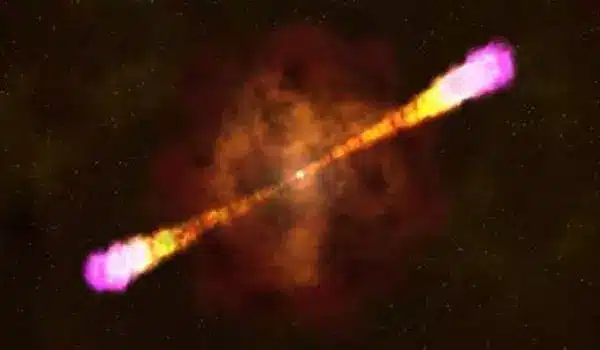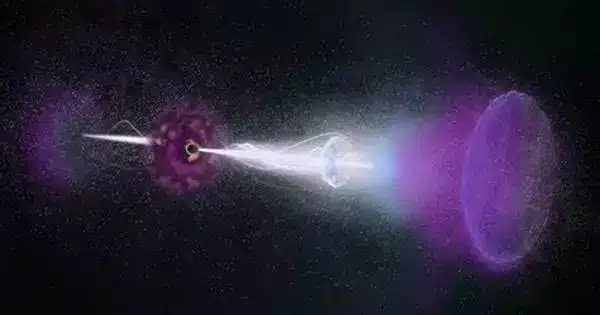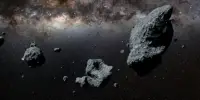GRBs are some of the most energetic and intriguing occurrences in the cosmos. They are extremely brief and strong bursts of gamma-ray radiation that can last milliseconds to minutes. GRBs are normally classified as either long-duration or short-duration. Long-duration GRBs are expected to be caused by the core collapse of massive stars, whereas short-duration GRBs are thought to be caused by the merging of compact objects like neutron stars or black holes.
While astrophysicists previously thought that only supernovae could produce extended gamma-ray bursts (GRBs), a 2021 observation revealed that compact-object mergers can also produce the phenomena. A new simulation confirms and explains this discovery. If the accretion disk around the black hole is big, it will launch a jet that will last many seconds, similar to a long GRB from a merger.
Last year, Northwestern University researchers presented new observational evidence that lengthy gamma-ray bursts (GRBs) can emerge from the merger of a neutron star with another compact object (either another neutron star or a black hole), a previously unthinkable discovery.
Now, another Northwestern team offers a potential explanation for what generated the unprecedented and incredibly luminous burst of light.
Neutron-star mergers are an enthralling multi-messenger phenomenon that produces both gravitational and electromagnetic waves. However, because of the vast spatial and temporal scale separations involved, as well as the diverse physics operating across these scales, simulating these events poses a challenge.
Danat Issa
The astrophysicists discovered that the post-merger black hole can launch jets of material from the ingested neutron star after building the first numerical simulation that follows the jet evolution in a black hole-neutron star merger out to huge distances.
The mass of the furious swirl of gas (or accretion-disk) around the black hole, however, and the strength of the disk’s magnetic field, are the critical ingredients. When the magnetic field is strong in huge disks, the black hole emits a short-duration jet that is significantly brighter than anything ever seen in measurements. When the huge disk’s magnetic field is weaker, the blackhole emits a jet with the same luminosity and duration as the enigmatic GRB discovered in 2021 and published in 2022.
Not only does the new discovery help explain the origins of long GRBs, it also gives insight into the nature and physics of black holes, their magnetic fields, and accretion disks. The study will be published in the Astrophysical Journal.

“So far, no one else has developed any numerical works or simulations that consistently follow a jet from the compact-object merger to the formation of the jet and its large-scale evolution,” said Northwestern’s Ore Gottlieb, who co-led the work. “The motivation for our work was to do this for the first time. And what we found just so happened to match observations of GRB211211A.”
“Neutron-star mergers are an enthralling multi-messenger phenomenon that produces both gravitational and electromagnetic waves,” said Danat Issa of Northwestern, who co-led the research with Gottlieb. “However, because of the vast spatial and temporal scale separations involved, as well as the diverse physics operating across these scales, simulating these events poses a challenge.” For the first time, we were able to completely model the entire neutron star merging process.”
During the research, Gottlieb was a CIERA Fellow at Northwestern’s Center for Interdisciplinary Exploration and Research in Astrophysics (CIERA); now he is a Flatiron Research Fellow at the Flatiron Institute’s Center for Computational Astrophysics. Issa is a graduate student in the Department of Physics and Astronomy at Northwestern’s Weinberg College of Arts and Sciences and member of CIERA. Issa is advised by paper co-author Alexander Tchekhovskoy, an associate professor of physics and astronomy at Weinberg and member of CIERA.
Curious kilonova
When astronomers first saw GRB211211A in December 2021, they presumed the 50-second event was caused by the implosion of a huge star. However, in studying the lengthy GRB’s late-time emission, known as the afterglow, scientists discovered evidence of a kilonova, a rare event that occurs only after the merger of a neutron star and another compact object.
The discovery (published in Nature in December 2022) challenged the long-held and widely acknowledged belief that only supernovae could produce lengthy GRBs. “GRB 211211A reignited interest in the origin of long-duration GRBs that are not associated with massive stars, but are most likely originating from compact binary mergers,” Gottlieb added.
From pre-merger to long GRB
To learn more about what happens during compact-merger events, Gottlieb, Issa, and their colleagues attempted to mimic the entire process, from before the merger until the end of the GRB event, when the GRB-producing jets turn off. The complete scenario had never been modeled previously because it is such a tremendously computationally expensive undertaking. Gottlieb and Issa overcome this obstacle by separating the scenario into two simulations.
First, the scientists ran a simulation of the pre-merger phase. The output from the first simulation was then fed into the post-merger simulation.
“Because the space-time used by the two simulations is different, this remap was not as straightforward as we had hoped, but Danat figured it out,” Tchekhovskoy said. “The daisy chaining of the two simulations allowed us to make the computation much less expensive,” Gottlieb said. “The physics is very complicated in the pre-merger stage because there are two objects. It gets much simpler after the pre-merger because there is only one black hole.”
The compact objects first fused in the simulation to form a larger black hole. The black hole’s powerful gravity drew the debris of the now-destroyed neutron star toward it. Some of the debris first whirled about the black hole as an accretion disk before falling into it. The developing disk in the configuration investigated was unusually large, with one-tenth the mass of our sun. When the mass from the disk plummeted into the black hole, it propelled the black hole to create a jet that sped to near light speed.
Disk properties matter
A surprise emerged as the researchers adjusted the strength of the massive disk’s magnetic field. Whereas a strong magnetic field resulted in a short, incredibly bright GRB, a weak magnetic field generated a jet that matched observations of long GRBs.
“The stronger the magnetic field, the shorter its lifetime,” Gottlieb explained. “Weaker magnetic fields produce weaker jets, which the newly formed black hole can sustain for a longer period of time.” The huge disk, in conjunction with weak magnetic fields, can sustain a GRB consistent with data and comparable to the intensity and lengthy duration of GRB211211A. Although we discovered this particular binary system to cause a lengthy GRB, we anticipate that additional binary mergers that produce huge disks would produce a similar result. It’s just a matter of post-merger disk mass.”















